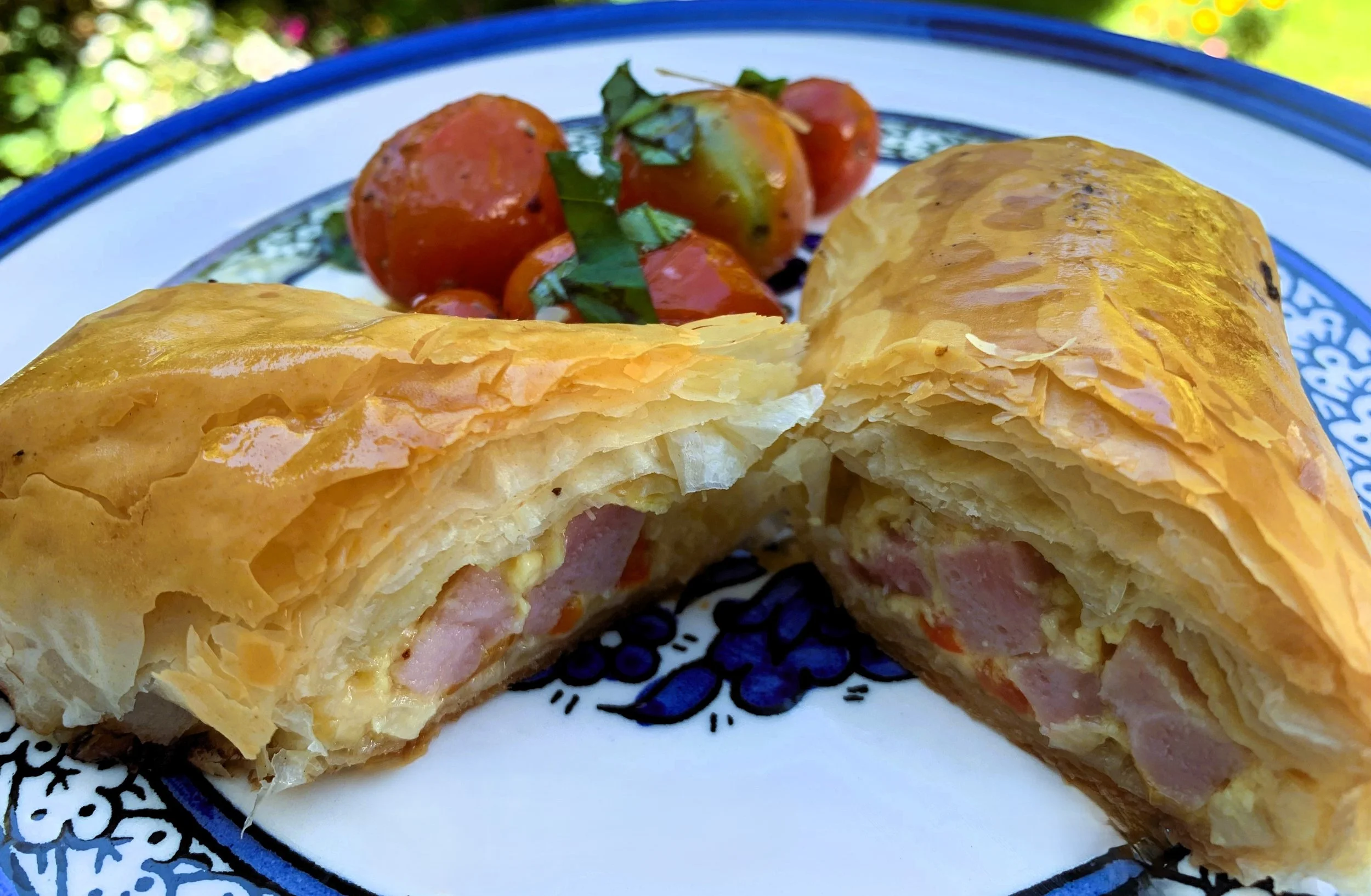Turkish Filo Ham Rolls
A ham, onion, cheese and egg mixture is wrapped with sheets of filo pastry, then rolled and baked. The filling is flavorful and smooth and the filo - all the glorious buttery crunch you would expect. A bundle of yum!
Turkish Ham Filo Rolls (Yufka Ham Rolls)
6 ounces ham 2 tablespoons butter 2 tablespoons minced green onion 2 egg yolks 1/4 cup heavy cream 1 clove garlic, minced 12 sheets Filo (phyllo) pastry, thawed (almost 1 wrapped package of filo sheets) dash of hot pepper sauce or pinch of dried red pepper flakes freshly ground black pepper 6 tablespoons grated Swiss or Parmesan cheese dash of worcestershire sauce 1/2 cup melted butter
-Cut ham into small 1 inch pieces. Saute ham in 2 tablespoons melted butter with green onions and garlic, just to warm thoroughly. Remove from heat.
-In a small bowl, beat egg yolks with cream; stir this mixture into the ham along with dash of worcestershire sauce, hot pepper sauce, and ground pepper. Warm over low heat. Folding the ham into the sauce until it thickens but don’t let it boil. Set aside to cool and thicken.
-On a clean working surface, lay out one sheet of filo pastry. Using a pastry brush, brush the filo with melted butter covering the pastry completely, then top with another sheet of filo. Butter the second sheet of filo, then fold the sheet in half to form a square-ish rectangular shape. Brush the exposed surface again with butter.
-Place the square of filo, with one point toward you to create a diamond shape as you look at it. Spoon a sixth of the filling toward the center of the filo square and slightly towards the point closest to you. Fold this corner up and over filling and roll half way. Take the two adjacent points, and fold over the created roll. Brush the exposed, unbuttered surfaces with butter as you roll up the filling, which will help it to hold together. Continue to roll up the filo and ham up to the top so that the ham is completely encased in the filo.
-Place completed rolls seam side down, on a lightly buttered baking sheet. Repeat with remaining ingredients. Brush any exposed surfaces with more butter. Bake at 375 degrees for about 20 minutes, until the rolls are golden. Allow to cool for 5 minutes before serving. Makes 6 Yufkha rolls. Serve with lemon wedges if desired. Delicious served warm or at room temperature.
Mix ham filling as described in recipe. Then unroll and layout the sheets of filo pastry.
Place one sheet of the filo on a clean working surface, then brush thoroughly with melted butter. Top with another sheet of filo pastry - again brush thoroughly with butter.
Fold the pastry in half to create a square-ish shape, then brush surface again with butter.
Turn the pastry so that one point is facing you. Place about ½ cup filling toward the middle of the diamond but a bit closer to the point facing you.
Fold the point facing you up and up and over the filling, rolling snugly. Butter the exposed surface of the filo.
Fold the two adjacent points over the bundle, then brush all exposed edges with more butter.
Continue to roll toward the remaining point until the bundle is completely rolled. Brush all exposed surfaces of the pastry with butter again.
Be sure all edges are buttered and snugly fitted with in the bundle.
Place bundles seamside down on an greased baking sheet, with a rim.
Bake at 375 degrees for about 20 minutes, until golden. Remove from oven and let cool 5 - 10 minutes before serving.
Serve on a plate or platter then garnish with parsley and fresh quartered lemons.
Filo Ham Rolls can be served whole or sliced diagonally in the middle.
Up close and personal - are you ready to take a bite. Enjoy the glorious buttery crunch!
PERSNICKETY NOTES:
**The term Yufka refers to a type of flat bread made in Turkey which is much like Lavash bread, but thicker than the paper thin texture of filo sheets. However, filo is a good substitute and approximates the flavor and crunch of Yufka rolls. If you can find Yufka in a Turkish or Middle Eastern grocery, do give it a try and see which you like better as the wrapper.
**Butter, butter, butter and more butter - yes! All exposed surfaces of the filo must be brushed with warm melted butter to ensure that every bit of the pastry is crunchy and flavorful. Any exposed surfaces of the pastry that have not been buttered will dry out and crumble while cooking. Yes, you can use other fats, such as olive oil or margarine to brush on the pastry, but you will be sacrificing the wonderful flavor created with the butter. And if you’re going for best flavor, butter is a must!
**Once your filo pastry is made and cooled, do not cover it with plastic wrap as the wonderful crunch you’ve worked so hard to create will go soft and soggy! To store leftover bundles do not store in airtight containers - just cover very loosely with foil and store in the refrigerator. Filo dishes can be made ahead and frozen, but only before baking. At this point they can be wrapped in plastic or stored in the freezer in air tight containers. If you try to store filo after baking, once again you will have a soft, soggy result. Not nearly as delicious.
**Working with Filo can be a bit frustrating, but if you follow these steps and inhale a dose of patience, you will get the hang of it.
1 - Be certain your filo is completely thawed. If you are working with a completely frozen package, keep the filo in its plastic sleeve then heat for 30 seconds on full power in your microwave. Let it rest in the sleeve for 10 minutes, then give it another 20 seconds on full power in the microwave. Let the filo sit another hour before working with it. (The best method is to set your pastry out from the freezer at room temperature about 5 hours before working with it or overnight.)
2 - When ready to create your filo masterpiece, open the sleeve and pull out the filo sheets. Gently open the package and try to lay the stack of sheets flat on your counter. Unfold any sheets that aren’t flat carefully so that the entire package of leaves lay on top of one another.
3 - As you work with the filo, cover the leaves you have not yet used with a piece of plastic wrap to keep them from drying out. You will find that as you become more experienced working with filo, you will be able to work faster and this step won’t be necessary.
4 - If you encounter leaves that are stuck together, gently try to separate them from one another. But don’t panic if a piece tears and you have just pieces of a sheet. Just place them into your dish, patching as you go and buttering to keep the patches in place. In the end product, you won’t see or notice the patchwork. It is nice to have the final sheet or two in one piece, such as for baklawa, but if you can’t see the torn layers, no one will ever notice. So be patient and enjoy the journey!
















